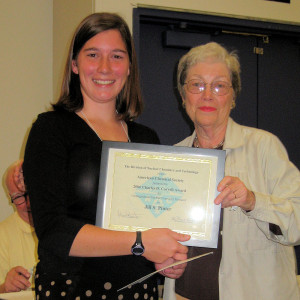The 2006 Coryell Award winner, Jill Pinter from Hope College, was recognized at the NUCL Business Meeting during the Spring ACS National Meeting. Jill did her undergraduate research project under the direction of Profs. Ken Brown, Paul DeYoung, and Graham Peaslee.

Jill Pinter and Darleane Hoffmann
Jill used Rutherford Backscattering Spectrometry (RBS) to investigation film thickness and uniformity of chemically-modified electrodes. RBS is an analytical technique that is used to determine the structure and composition of materials by impinging an ion beam on a sample and detecting the backscattered ions. RBS was used to characterize the intrinsic properties of a thin organic film composed of the ruthenium complex, [(bpy)2Ru(5-phenNH2)]Cl2 • H2O, on a glassy carbon electrode. The film was placed on the electrode surface via electropolymerization, such that the thickness of the film depends on the number of cycles of electropolymerization. A 1.7-MV Pelletron tandem particle accelerator at the Hope College Ion Beam Analysis Laboratory (HIBAL) was used to produce a beam of He2+ ions at 4.533 MeV. The beam was focused on the glassy carbon portion of the electrode with beam spot ~1 mm in diameter. The backscattered ions were detected at 169.7-deg by a silicon surface-barrier detector with a solid angle of ~4 msr. The results show that the film has an unusual composition of two layers: an outer layer of uniform ruthenium concentration, and an inner layer that starts at the same uniform ruthenium concentration, but decreases linearly to the electrode surface. The total amount of ruthenium present in the films was found to increase linearly with the number of electropolymerization cycles, and the same trend is observed for film thickness as well. The thickness of the films was determined to range between 1000 to 2500 nm for 5 to 20 electropolymerization cycles, respectively.
